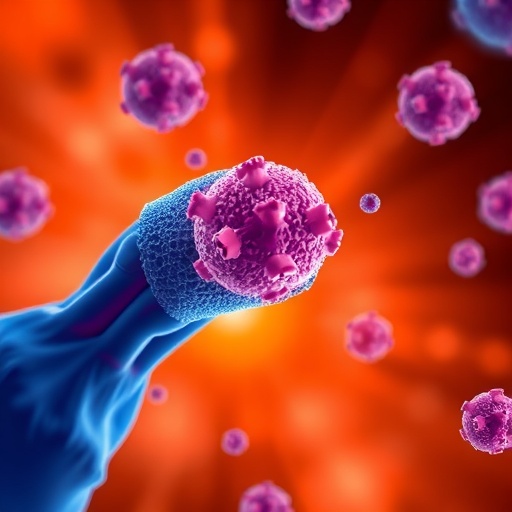In the relentless pursuit of more precise and effective therapies for lung cancer, researchers at the University of Missouri have unveiled a groundbreaking approach that centers around the manipulation of extracellular vesicles (EVs)—microscopic, bubble-like structures secreted by cells to communicate with their environment. These EVs, minute enough to be roughly 3,000 times thinner than a human hair, carry a wealth of biological information and are released in vast numbers by all cell types, including malignant cancer cells. The novel research led by Assistant Professor Akhil Srivastava has pinpointed a crucial protein called CD81 within cancer-derived EVs that appears to facilitate tumor progression, opening new avenues for targeted treatment strategies.
Extracellular vesicles act as carriers of molecular messages that can influence the behavior of recipient cells. While EVs emanating from healthy cells typically transport signals that promote normal biological functions, those derived from cancer cells have the capacity to transmit pathogenic signals which stimulate tumor growth, metastasis, and resistance to conventional therapies. Srivastava’s work revolves around deciphering the molecular contents of these vesicles, particularly focusing on the role of the tetraspanin protein CD81 in lung cancer’s cellular communication network.
Through meticulous experimental studies, Srivastava and his team discovered that EVs produced by lung cancer cells consistently exhibit heightened levels of CD81 compared to those secreted by normal cells. This differential expression suggests that CD81 is intimately involved in the mechanisms by which cancer cells manipulate their surroundings to foster disease progression. The team employed small interfering RNA (siRNA) technology to silence the CD81 gene within lung cancer cells, effectively reducing the production of this protein and subsequently altering the functional properties of the EVs.
The results were striking: lung cancer cells with suppressed CD81 generated EVs that not only lost their tumor-promoting capabilities but actively contributed to tumor shrinkage in preclinical models. This phenomenon underscores the pivotal role that CD81 plays in the pathophysiology of lung cancer and validates the concept of targeting EV-associated proteins as a therapeutic strategy. Srivastava emphasizes that this modulation disrupts the cancer cells’ ability to communicate deleterious instructions, thereby impeding tumor growth and dissemination.
Beyond understanding the pathological role of EVs, Srivastava has envisioned a transformative therapeutic application by engineering these vesicles to function as precision delivery vehicles for anti-cancer agents. Much like how postal services label packages for specific destinations, the team endeavors to direct engineered EVs exclusively toward malignant lung cells, thereby minimizing collateral damage to healthy tissues—which remains a significant drawback of conventional chemotherapy and immunotherapy modalities.
In a related experimental breakthrough, Srivastava demonstrated the feasibility of loading therapeutic siRNA molecules into modified EVs. These genetically coded snippets, designed to trigger cancer cell apoptosis, were packaged within vesicles reprogrammed to retain targeting specificity. When administered in preclinical lung cancer models, this bespoke EV platform successfully delivered the genetic payload to cancer cells, selectively inducing cell death while sparing normal cells, a hallmark of precision medicine.
This research marks a significant step forward in the burgeoning field of EV-based therapeutics, combining cutting-edge molecular biology, nanotechnology, and oncology. The exploitation of EVs as biological drones capable of delivering therapeutic instructions opens promising vistas for the treatment of not only lung cancer but potentially a myriad of other malignancies characterized by aberrant EV signaling.
Srivastava credits the collaborative, multidisciplinary environment at the University of Missouri for catalyzing these advances. The convergence of diverse expertise—including surgeons, veterinarians, bioengineers, and molecular biologists—facilitates rapid translational progress from bench to bedside. Such a team-based approach is vital for addressing complex diseases where biological, engineering, and clinical perspectives must harmonize to generate effective solutions.
Moreover, the molecular intricacies of EV biology remain an active frontier of research. By elucidating the full spectrum of biomolecules—proteins, RNAs, lipids—that EVs ferry between cells, scientists aim to reconstruct the communication maps within tumor microenvironments. This knowledge will empower the design of tailor-made interventions that can reprogram malignant signals into therapeutic ones.
Despite challenges ahead, including the scale-up of EV production and ensuring delivery efficiency in human patients, Srivastava’s findings inject optimism into the lung cancer research community. The promise of converting malignant EVs from agents of disease into therapeutic allies signals a paradigm shift in cancer treatment. As further refinements unfold, the clinical translation of EV-based platforms could revolutionize oncology, offering patients therapies that are more effective, less toxic, and finely tuned to the molecular nuances of their disease.
In summary, the University of Missouri’s pioneering research underscores the dualistic nature of extracellular vesicles in lung cancer – wielding both the potential to propagate malignancy and the capacity to deliver bespoke therapeutic payloads. The strategic perturbation of CD81 on EV surfaces represents a novel intervention point, enhancing our ability to disrupt tumor-supporting communications and harness the full therapeutic utility of these diminutive vesicles. This innovative approach propels the vision of precision oncology where treatments are not only targeted but inherently biological, leveraging the cell’s own communication machinery against cancer itself.
Subject of Research: Animals
Article Title: Perturbed CD81 in lung-cancer-derived extracellular vesicles modifies its function in cancer pathophysiology
News Publication Date: 2-Sep-2025
Web References: http://dx.doi.org/10.1016/j.omton.2025.201037
Image Credits: University of Missouri
Keywords: Cell biology, Biochemistry, Biophysics, Computational biology, Developmental biology, Evolutionary biology, Genetics, Immunology, Molecular biology, Pharmacology, Bioengineering, Biomedical engineering, Clinical medicine, Diseases and disorders




